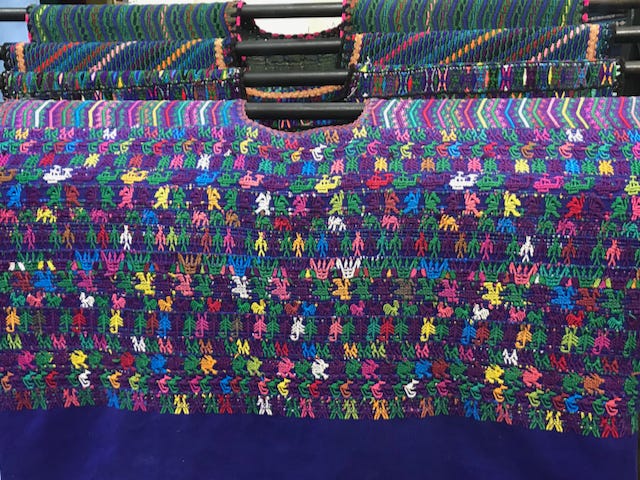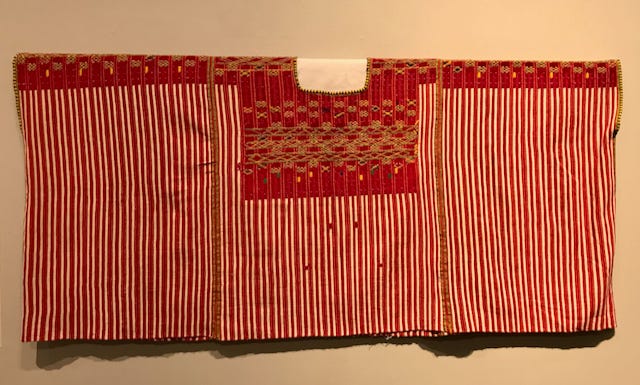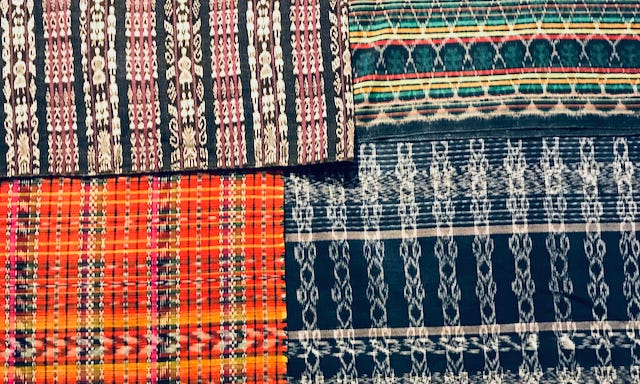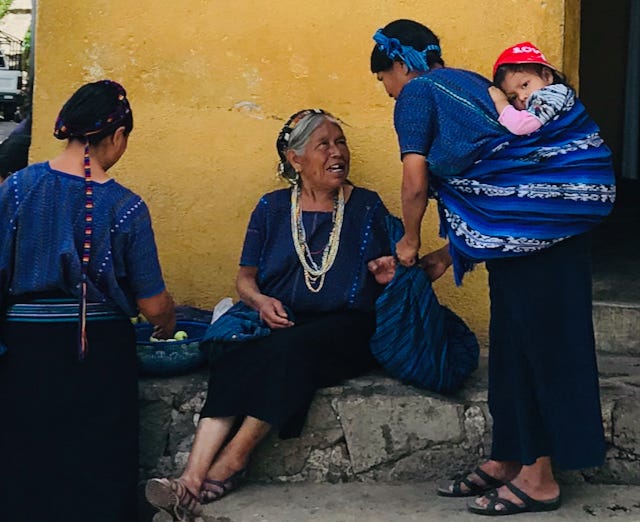Continuity and Change: The case of Maya trajes
This post went out to my Substack newsletter subscribers on May 24. It's an excerpt from chapter six of The Fabric of Civilization. Like my recent column on Princeton Reunions, it looks at continuity amid change (and vice versa).
It’s early evening, and the woman in red looks like she’s heading home after a day in the market of San Juan La Laguna, a town on the shores of Lake Atitlán in Guatemala. She is wearing a traditional ensemble, or traje—except for the smartphone tucked into her tightly cinched faja, a wide, handwoven sash. Drawn by the contrast between old and new, I ask a Guatemalan friend to ask if I can take her photo. Something gets lost in translation. Happy to cooperate, she removes the phone and hides it behind her back. No, please tell her I want the phone in the picture. She proudly poses with it in her left hand. Still not part of the outfit. Oh well.
Although it includes the essential components that mark her as a Maya, the woman’s traje isn’t as traditional as it initially appears. Her top is not a handwoven cotton huipil but a factory-made blouse, probably polyester, adorned with machine embroidery and rhinestones—less expensive and more practical for everyday wear than the heavy cotton rectangles woven on a backstrap loom and sewn together. Her skirt, or corte, is the critical component of the outfit; the Guatemalan idiom “Lleva corte,” or “she wears a [traditional] skirt,” means a woman is indigenous. Yardage wrapped around the body and secured by the faja, hers looks like it came off a traditional floor loom—a technology introduced by the Spanish—but the red and navy plaid reflects fashion rather than custom. Her outfit is as up-to-date as her nail polish and cell phone. Yet it is still indisputably Maya.
In the well-established romantic narrative, material progress represents a devil’s bargain: shoes, running water, and vaccines at the cost of beauty, identity, and meaning; uniqueness replaced by homogenized global culture. Maya trajes illustrate a different—and likely more common—pattern. Left to their own devices, consumers rarely treat tradition and modernity as all-or-nothing choices. They find ways to maintain their inherited identities, including the material manifestations that signify belonging, while satisfying the desire for novelty and self-expression.
Contrary to the nostalgic vision of timeless peasant customs, Guatemalan textiles have always been dynamic. Many huipiles incorporate colorful designs in supplementary weft brocade, some geometric, others featuring stylized animals, plants, and people. The bright threads to make the designs initially came from Chinese silk floss—“There are five generations of Chinese in Guatemala,” notes textile collector Raymond Senuk—and, when World War II interrupted the supply, weavers adopted shiny mercerized cotton.
Picked out row by row with fingers or a pointed stick similar to a knitting needle, the patterns range from ancient Maya imagery to contemporary innovations. At a shop in Antigua that sells secondhand huipiles, I bought one featuring rows of donkeys, rabbits, scorpions, roosters, quetzals (the national bird), baskets, spiders, humans, and, clinching the sale, helicopters! When magazines began printing cross-stitch patterns in the nineteenth century, Maya weavers adapted the designs, inventing a new form of brocade, known as de marcador, in which the supplementary threads wrap around the warp so that both sides of the fabric are identical.
Without giving up backstrap weaving, indigenous people also embraced European floor looms, using them to produce fabric for skirts, aprons, and trousers. Probably inspired by Asian fabrics, they developed a new tradition of dyeing called jaspe. Better known elsewhere as ikat, jaspe is a complicated tie-dye technique in which undyed threads are tied to block out a pattern that appears when the cloth is woven. (You can identify ikat by the slightly blurred appearance of the figures.) In addition, today’s floor-loom cloth frequently incorporates metallic threads made of coated polyester film.
Far from a dying art, says Senuk, “weaving is fine in Guatemala. But it’s changing, really dramatically. In the last twenty years, dramatic things have happened.” Until a few decades ago, you could easily identify a Maya woman’s village simply by looking at her clothes. Although each weaver created her own patterns, they worked within well-defined rules of construction, background colors, and decorative designs. A huipil from San Juan La Laguna would feature twenty-four embroidered squares, arranged as four rows of six, below a yoke decorated with zigzags, all on a red striped background comprising two woven pieces. The accompanying corte would be black and white.
In the northern highlands village of Todos Santos Cuchumatán, by contrast, a huipil would be sewn from three panels, woven with alternating red and white stripes. The center section would have geometric patterns brocaded in supplementary weft, with a yoke adorned with store-bought rickrack. The stripes could be larger or smaller and the brocade designs could vary, sometimes spreading to the other panels. But to a knowledgeable observer the blouse would clearly declare that its wearer hailed from Todos Santos. Every village had its own distinctive combination of elements.
By the 1990s, things began to change, as women started to buy and sell clothes in local markets rather than making everything themselves. “I would see a woman in the market that I would know was from San Antonio Aguas Calientes and she would be wearing a huipil from the Alta Verapaz, from Cobán, and I would say, ‘Porque?’” recalls Senuk. “And she would say, ‘Because I like it.’” Picking and choosing from other villages’ trajes evolved into new “pan-Maya” fashions that weren’t specific to any particular place.
Around the turn of the century, Maya women invented the novel style that captured my attention on the street in San Juan La Laguna: the monochrome outfit, with huipil, sash, and skirt—and sometimes apron, hair band, and shoes—all in coordinated colors. “What you did was you now got a base color—say, turquoise,” explains Senuk. “You now went and got a turquoise huipil that was machine embroidered with related colors. The skirt was an ikat skirt but with turquoise bands in it. And the belt was a Totonicapán-style woven belt but turquoise. Now you were either turquoise, pink, café, purple—and all these things were possible choices. And they had no village significance at all.” Monochrome fashion makes it easy to produce a striking outfit that is simultaneously Maya and Instagrammable: #chicasdecorte.




